‘I heat my Essex home with a data centre in the shed’
Ben SchofieldBBC East, political correspondent
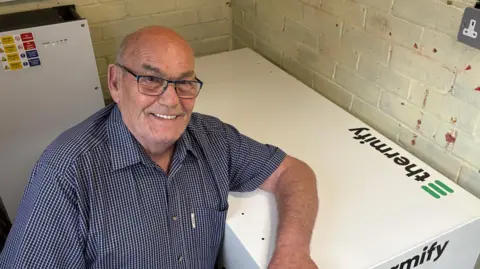 Ben Schofield/BBC
Ben Schofield/BBCAn Essex couple have become the first people in the country to trial a scheme that sees them heat their home using a data centre in their garden shed.
Terrence and Lesley Bridges have seen their energy bills drop dramatically, from £375 a month down to as low as £40, since they swapped their gas boiler for a HeatHub – a small data centre containing more than 500 computers.
Data centres are banks of computers which carry out digital tasks. As the computers process data, they generate lots of heat, which is captured by oil and then transferred into the Bridges’ hot water system.
Mr Bridges, 76, says keeping his two-bed bungalow near Braintree warm was a necessity as his wife has spinal stenosis and is in “a lot of pain” when it gets colder.
“It truly is brilliant,” Mr Bridges continues. “I’m over the moon that we got picked to trial this out. You can’t fault the heating system – it is a 100% improvement on what we had before.”
“You don’t need to go to a sauna after coming here,” Mrs Bridges, 75, adds.
The HeatHub was developed by Thermify and is part of UK Power Networks’ SHIELD project, which aims to come up with innovative ways for low-income households to transition to net zero.
Through SHIELD, the Bridges also had solar panels and a battery put in, which have contributed to their savings.
 Ben Schofield/BBC
Ben Schofield/BBCMr Bridges, a retired RAF sergeant, says despite putting “the heating up fairly high to keep it nice and warm”, his bill has fallen to between £40 and £60 each month.
“I think it’s fantastic because it’s eco-friendly,” he continues, “we’re not burning any gases, so it’s green – it’s environmentally friendly.”
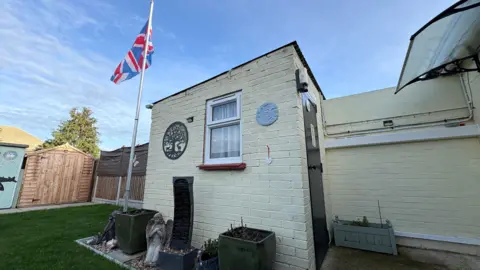 Ben Schofield/BBC
Ben Schofield/BBCThermify co-founder and CEO Travis Theune says the Bridges’ HeatHub will eventually be part of a “remote and distributed” data centre, involving many units processing data for customers.
While not designed for the heavy processing needed for artificial intelligence, Mr Theune says the system could run things like apps or analyse large volumes of data.
He says the company wanted to design a system to provide both “clean” and “affordable” energy because “finding a way to do both was a hard problem”.
The project is still in the pilot phase, but in the future, clients will pay Thermify to process their data using the HeatHubs.
Mr Theune adds the system provides “clean, green heat at a low-to-no price point” because “the electricity that’s generating that heat is paid for by somebody else”.
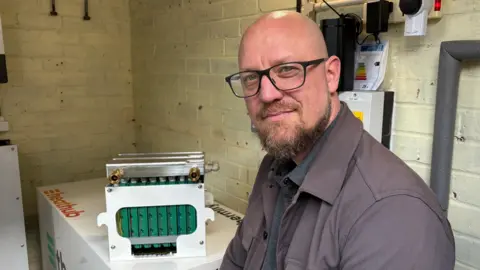 Ben Schofield/BBC
Ben Schofield/BBCThe Bridges’ landlord, social housing provider Eastlight Community Homes, is also part of SHIELD.
Daniel Greenwood, Eastlight’s head of asset management, says he hopes the next phase of the project will see 50 homes get HeatHubs, and adds: “We’ve seen great results for the current installation, and although this is the first of its kind, we’re looking to roll that out more broadly.”
Jack McKellar, UK Power Networks’ innovation programme manager, says: “We don’t want anyone to miss out on the benefits of new and emerging technologies, as the UK moves towards a greener future.”
 Ben Schofield/BBC
Ben Schofield/BBCData centres help run the modern world. It is estimated they consume about 2.5% of the UK’s electricity, and as more are built, their power demand could rise fourfold by 2030.
Thermify is not alone in trying to capture and use the heat generated by data centres.
A swimming pool in Devon is being warmed by a washing machine-sized “digital boiler”.
The company behind that scheme is also involved in a proposal to build the Melbourn Energy Superloop – a combined solar-powered data centre and district heat network in south Cambridgeshire.
Milton Keynes University Hospital was also hoping to be the first place in the city to benefit from £95m plans to share heat from a new data centre.
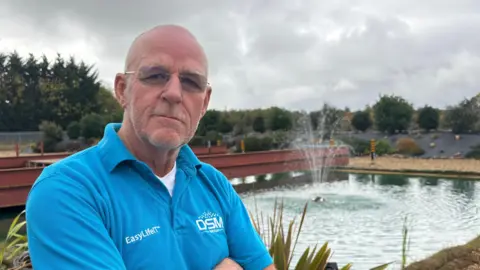 Ben Schofield/BBC
Ben Schofield/BBCAccording to the International Energy Agency, data centres use up to 30% of their electricity consumption on cooling.
Mike Richardson, the 66-year-old founder and owner of DSM, says he had tried to incorporate “nature” as much as possible into his data centre at a former RAF base just off the A1 near Peterborough.
A 200kW array of solar panels helps power it, and a 500 cubic-metre artificial lake cools it down.
The lake is filled with water collected from the roof of an old aircraft hangar and pumped from two boreholes.
Four heat exchangers are submerged in the 1.7 metre deep water, which is also home to dozens of koi carp and tench – fish that have their own role in the operation.
“We need to keep the pipes clean, and they eat the algae,” Mr Richardson tells the BBC.
With a 400kW capacity, the data centre is relatively small – or “boutique”, according to Mr Richardson.
 Ben Schofield/BBC
Ben Schofield/BBCWarm water is pumped from data racks to heat exchangers in the lake, then the cooled water is sent back inside, in a closed loop.
Traditional cooling systems often rely on compressing a chemical coolant, which can be toxic.
“Keeping away from chemicals is an important thing for us,” Mr Richardson says.
He adds that because there was no need for compression, the setup used much less electricity for cooling.
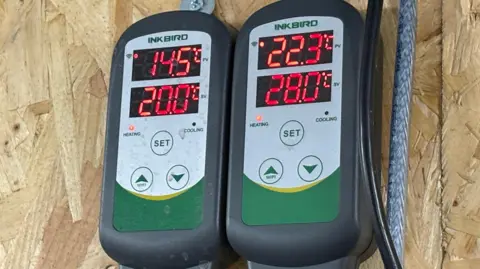 Ben Schofield/BBC
Ben Schofield/BBCDoes it work?
“Yes, it works – it most definitely works,” Mr Richardson says.
But adds that relying on nature comes with “challenges” because “nature by default is not something which is, you know, stable”.
“It takes a bit of management, but it’s all doable,” he continues.
The system, while small-scale, can be scaled up with a larger body of water, he explains.
“Water is one of the best mediums for heat transfer,” he says.
Microsoft has also experimented with an underwater data centre.
Project Natick saw more than 850 servers sunk in a giant metal tube off the coast of Orkney between 2018 and 2020.
There are reports that Chinese companies were also planning to sink data centres into the ocean.
Share this content:
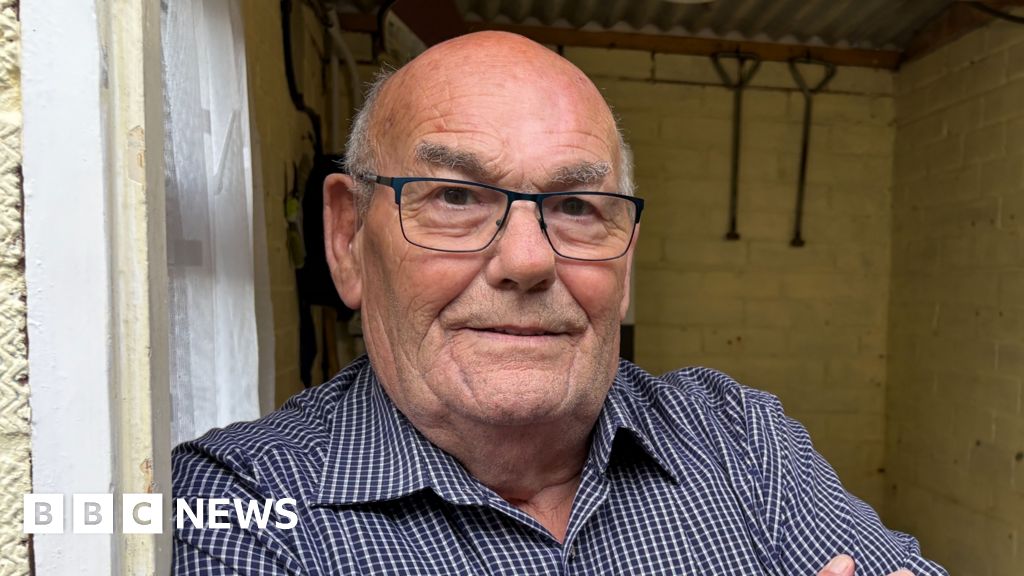










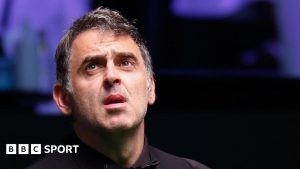



إرسال التعليق